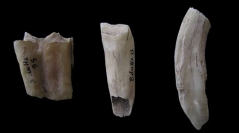

 Comptes Rendus Palevol
10 (1) - Pages 49-59
Comptes Rendus Palevol
10 (1) - Pages 49-59The Baume du Houx, in the Var department of France, situated on the edge of a cliff, has yielded a bone assemblage composed mainly of domesticated ungulate phalanges and numerous digested remains. This fauna was collected from the surface, along with numerous potsherds probably attributable to the Bronze Age or the Early Iron Age, but their contemporaneity with the fauna has not been demonstrated. This study has employed diverse taphonomic methods in order to determine the agent of bone accumulation, such as assemblage composition, skeletal part representation, and bone damage patterns. The high degree of digestion observed on the material and the size of the prey correspond with an accumulation observed in a bearded vulture nest. The site's context, on a cliff, supports this conclusion. This is the first discovery of a bearded vulture nest in Provence region. Chronologically, the presence of domestic species digested by the vulture places the nest's occupation sometime after the Neolithic, without any further precision.
Taphonomy, Gypaetus barbatus, Digestion marks, Bone fragmentation, South of France, Holocene, Potsherds